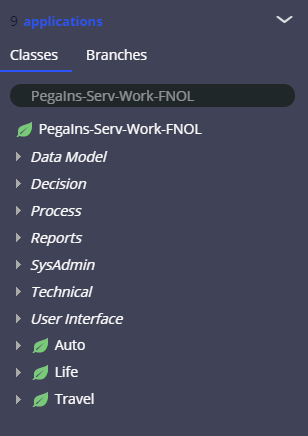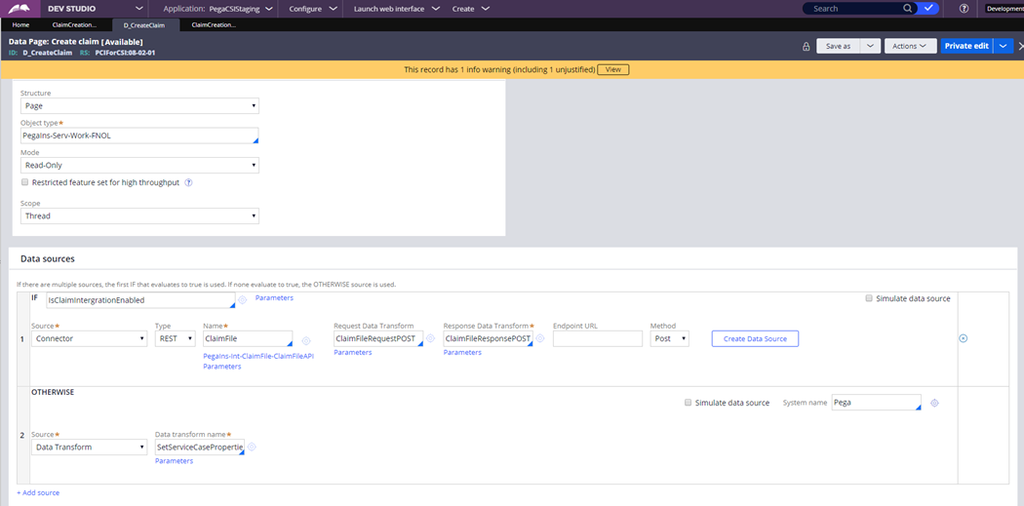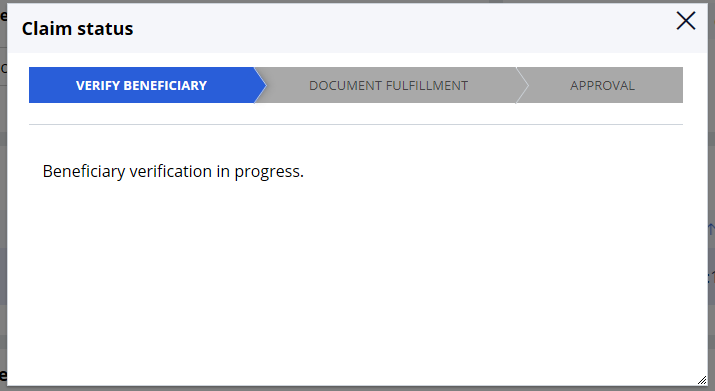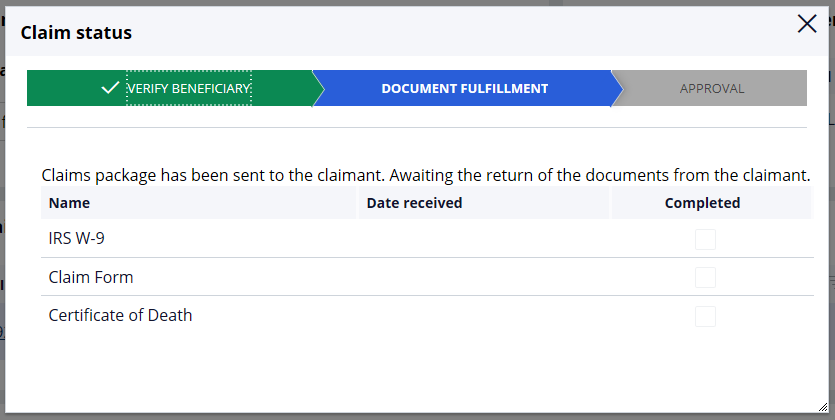Insurance claims integration
Pega Customer Service for Insurance includes an integration with Pega Claims for Insurance for claim ID creation, and for claim review, adjudication, and approval. You can enable and use the built-in claims integration with Pega Claims for Insurance, or you can extend Pega Customer Service for Insurance to integrate with a third-party claims system.
Enabling the integration with Pega Claims for Insurance
If Pega Customer Service for Insurance will use Pega Claims for Insurance to create and manage claims, enable the integration.
To use a third-party claims system to create and manage claims, see "Support for integration with a third-party claims system", next.
- In the header of Dev Studio, search for and select the ClaimServiceURL application settings rule.
- Enter the URL of the server where Pega Claims for Insurance is hosted in the appropriate production level.
- Click Save.
- In the header of Dev Studio, search for and select the GetClaimsStatusEndPointURL application settings rule.
- Enter the URL of the server where Pega Claims for Insurance is hosted in the appropriate production level.
- Click Save.
- In the header of Dev Studio, search for and select the PCIClaimFileAuthentication authentication profile rule.
- Configure the credentials that the Pega Customer Service for Insurance
connectors will use to communicate with Pega Claims for Insurance.The credentials should be the user name and password of a Pega Claims for Insurance operator with access to the Pega Claims for Insurance application. Typically, this operator is used for integration purposes only.
- In the User Name field, enter the user name.
- Click Set password.
- Enter the password, and then click Submit.
- Click Save.
Support for integration with a third-party claims system
You can extend Pega Customer Service for Insurance to integrate with a third-party claims system. Pega Customer Service for Insurance includes an integration with Pega Claims for Insurance that demonstrates a claims system integration.
Pega Customer Service for Insurance supports the following integrations with a third-party claims system:
Sending notice of loss information to a third-party claims system
Pega Customer Service for Insurance provides several extension points to support claim creation in a third-party claims system. The third-party claims system creates and then returns the claim ID.
First Notice of Loss (FNOL) class structure
The following image shows the class structure for a First Notice of Loss (FNOL) service case that is created under the PegaIns-Serv-Work-FNOL class. This class contains the extension points for claim creation.

Claim creation process flow and activity
The PegaIns-Serv-Work-FNOL class includes a generic ClaimCreationProcess flow that Pega Customer Service for Insurance calls at the end of the FNOL process.
The flow includes a ClaimCreationProcess activity that performs the following actions:
- Calls a data page to create a claim in a third-party claims system.
- Uses the response from a third-party claims system to create a local Claim File case in Pega Customer Service for Insurance. The local case has the same case ID as the claim in the third-party claims system. The Claim File case is a pointer case that gets created in either the PegaIns-Serv-Work-ClaimFile class or in a line of business-specialized version of that class, such as PegaIns-Serv-Work-ClaimFile-Life. The pointer case is required to support local storage of the claim information within Pega Customer Service for Insurance. Pega Customer Service for Insurance attaches the FNOL service case as a child case of the Claim File case.
The data page that creates claims in a third-party claims system is D_CreateClaim. The data page accepts a ClaimType input parameter that identifies the line of business (for example, Personal Auto) for the claim.

Claim creation data transform and data page
An extension point in the ClaimCreationProcess activity is the SetDataToCreateClaim data transform.
Extend this data transform to support the specialized classes for each line of business. After this extension is complete, the application can perform the required data transformation for the FNOL service case before starting the claim file creation process.Another extension point in the ClaimCreationProcess activity is the D_CreateClaim data page, which is displayed in the following image. This data page creates a claim in a third-party claims system. By default, the data page is configured to create a claim in Pega Claims for Insurance. To integrate with a different claims system, extend this data page to add the connector for the service provided in that claims system.

Enabling a third-party claims system for claim creation
In addition to the extension points described previously, the integration to the third-party claims system must be enabled as described below.
- Run the integration wizard to create connectors to a third-party claims system.
- Extend the D_CreateClaim data page to include the connector to a third-party claims system.
- In the request data transform rule for the connector, map all of the properties
that are collected for the FNOL service case to a third-party claims system
service input.
In the line of business-specialized classes, Pega Customer Service for insurance includes a SetServiceCaseProperties sample data transform. This data transform lists the properties collected in the service case for each line of business. Use this data transform as a model for mapping the request to a third-party claims system, based on the request structure of that system.
Retrieving real-time claim status information from a third-party claims system
When Pega Customer Service for Insurance has an integration to a third-party claims system, real-time claim status information displays from the third-party system.
Data page to display local Claim File case status information
The D_CustomerClaimCases data page retrieves the local Claim File case information based on the contact ID and policy ID of the policy owner or beneficiary. This data page is in the same class as the local pointer case.
In the Interaction Portal, the Claims section of the Policy composite uses the Claim File case information to display a list of customer claims, as shown in the following image. The Policy composite can display claim information for simple or complex claims, such as a life insurance policy with multiple beneficiaries.

Data page to retrieve claim status from third-party claims system
Extend the D_GetClaimsStatus data page to retrieve real-time claim status information from a third-party claims system.
To extend the data page, provide the input parameters required for your connectors to the third-party claims system. The response mapping from the third-party claims system uses the input parameters to map the properties from the third-party claims system to Pega Customer Service for Insurance properties.
In the Claims section of the Policy composite, click the Status hyperlink to open a Claim status window that displays real-time claims status information from a third-party claims system. The status information includes the different case stages of the claim file and whether a stage is complete.
Extend the case stages view (DisplayClaimStages section) to display the line of business-specific details. For example, for a Life Claim file, the case stages view displays the list of documents received from the beneficiary, as shown in the following images:


The D_CustomerClaimCases data page is sourced by an activity that gets the list of claim files. For each claim file, the activity calls the D_GetClaimsStatus data page to get the claim status from a third-party claims system. The result of this data page is stored in the ClaimStatus property, in the PegaIns-Data-Claim class. At runtime, the class definition of this property is specialized based on the line of business. For example, for Life Claim files, the ClaimStatus property is in the PegaIns-Data-Claim-Life class. The class specialization is achieved by using a Page-Change-Class step in the data page source activity.
Specializing the ClaimStatus property by line of business
After you create line-of-business data page properties, extend the ExtnForSpecificLOB line-of-business data transform that runs on the ClaimStatus property. Map the line-of-business-specific claim file details from the third-party claims system response to your Pega Customer Service for Insurance properties.
By default, the data transform in the PegaIns-Data-Claim base class is empty, because it is a stub for the base class. Extend the data transform in the line of business-specific classes as needed.
In Pega Customer Service for Insurance, the ExtnForSpecificLOB data transform (shown in the following image) is extended to work with Pega Claims for Insurance for the Life line of business only. Use this data transform as a model for your extensions.

A ClaimFileHistory clipboard page, in the PegaIns-Int-ClaimFile-GetClaimsStatusAPI class, is available within the scope of the ExtnForSpecificLOB data transform. The clip board page contains the response from the third-party claims system. If mapping is required for composite display, a customer modifies the ExtnForSpecificLOB data transform with that mapping, and then the clipboard page performs the mapping.
The response data transform for the D_GetClaimsStatus data page is the ClaimStatusResponseMapper data transform. This data transform populates the clipboard page from the REST service response. To ensure that your third-party claims system works correctly, verify that this page is populated with the service response.
Previous topic Adding support for Federated Case Management case types Next topic Pega Customer Relationship Management for Insurance suite of applications
